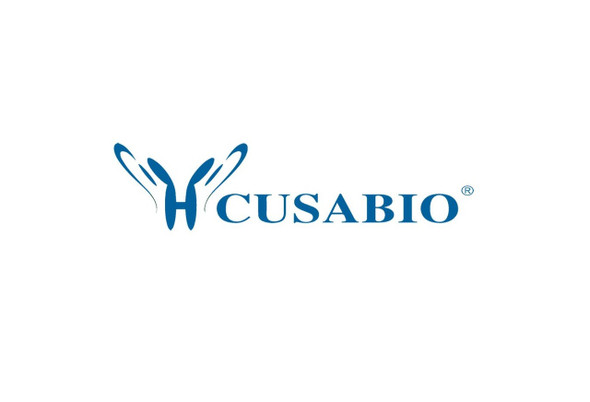Cusabio Human Recombinants
Recombinant Human Ras-related protein Rab-23 (RAB23) | CSB-EP891960HU
- SKU:
- CSB-EP891960HU
- Availability:
- 13 - 23 Working Days
Description
Recombinant Human Ras-related protein Rab-23 (RAB23) | CSB-EP891960HU | Cusabio
Alternative Name(s): DKFZp781H0695; HSPC137; MGC8900; Rab 23; RAB family small GTP binding protein RAB 23; Rab23; RAB23; member RAS oncogene family; RAB23_HUMAN; Ras related protein Rab 23; Ras-related protein Rab-23
Gene Names: RAB23
Research Areas: Neuroscience
Organism: Homo sapiens (Human)
AA Sequence: MLEEDMEVAIKMVVVGNGAVGKSSMIQRYCKGIFTKDYKKTIGVDFLERQIQVNDEDVRLMLWDTAGQEEFDAITKAYYRGAQACVLVFSTTDRESFEAVSSWREKVVAEVGDIPTVLVQNKIDLLDDSCIKNEEAEALAKRLKLRFYRTSVKEDLNVNEVFKYLAEKYLQKLKQQIAEDPELTHSSSNKIGVFNTSGGSHSGQNSGTLNGGDVINLRPNKQRTKKNRNPFSSCSIP
Source: E.coli
Tag Info: N-terminal GST-tagged
Expression Region: 1-237aa
Sequence Info: Full Length
MW: 53.7 kDa
Purity: Greater than 90% as determined by SDS-PAGE.
Relevance: The small GTPases Rab are key regulators of intracellular membrane trafficking, from the formation of transport vesicles to their fusion with membranes. Rabs cycle between an inactive GDP-bound form and an active GTP-bound form that is able to recruit to membranes different set of downstream effectors directly responsible for vesicle formation, movement, tethering and fusion. Together with SUFU, prevents nuclear import of GLI1, and thereby inhibits GLI1 transcription factor activity. Regulates GLI1 in differentiating chondrocytes. Likewise, regulates GLI3 proteolytic processing and modulates GLI2 and GLI3 transcription factor activity. Plays a role in autophagic vacuole assembly, and mediates defense against pathogens, such as S.aureus, by promoting their capture by autophagosomes that then merge with lysosomes.
Reference: "Expression of RAB-23 in human hair follicle." Ikeda A., Yamashita M. Submitted (MAR-1999)
Storage: The shelf life is related to many factors, storage state, buffer ingredients, storage temperature and the stability of the protein itself. Generally, the shelf life of liquid form is 6 months at -20?/-80?. The shelf life of lyophilized form is 12 months at -20?/-80?.
Notes: Repeated freezing and thawing is not recommended. Store working aliquots at 4? for up to one week.
Function: The small GTPases Rab are key regulators of intracellular membrane trafficking, from the formation of transport vesicles to their fusion with membranes. Rabs cycle between an inactive GDP-bound form and an active GTP-bound form that is able to recruit to membranes different set of downstream effectors directly responsible for vesicle formation, movement, tethering and fusion. Together with SUFU, prevents nuclear import of GLI1, and thereby inhibits GLI1 transcription factor activity. Regulates GLI1 in differentiating chondrocytes. Likewise, regulates GLI3 proteolytic processing and modulates GLI2 and GLI3 transcription factor activity. Plays a role in autophagic vacuole assembly, and mediates defense against pathogens, such as S.aureus, by promoting their capture by autophagosomes that then merge with lysosomes.
Involvement in disease: Carpenter syndrome 1 (CRPT1)
Subcellular Location: Cell membrane, Lipid-anchor, Cytoplasmic side, Cytoplasm, Cytoplasmic vesicle, autophagosome, Endosome membrane, Cytoplasmic vesicle, phagosome, Cytoplasmic vesicle, phagosome membrane, Lipid-anchor, Cytoplasmic side
Protein Families: Small GTPase superfamily, Rab family
Tissue Specificity:
Paythway:
Form: Liquid or Lyophilized powder
Buffer: If the delivery form is liquid, the default storage buffer is Tris/PBS-based buffer, 5%-50% glycerol. If the delivery form is lyophilized powder, the buffer before lyophilization is Tris/PBS-based buffer, 6% Trehalose, pH 8.0.
Reconstitution: We recommend that this vial be briefly centrifuged prior to opening to bring the contents to the bottom. Please reconstitute protein in deionized sterile water to a concentration of 0.1-1.0 mg/mL.We recommend to add 5-50% of glycerol (final concentration) and aliquot for long-term storage at -20?/-80?. Our default final concentration of glycerol is 50%. Customers could use it as reference.
Uniprot ID: Q9ULC3
HGNC Database Link: HGNC
UniGene Database Link: UniGene
KEGG Database Link: KEGG
STRING Database Link: STRING
OMIM Database Link: OMIM









